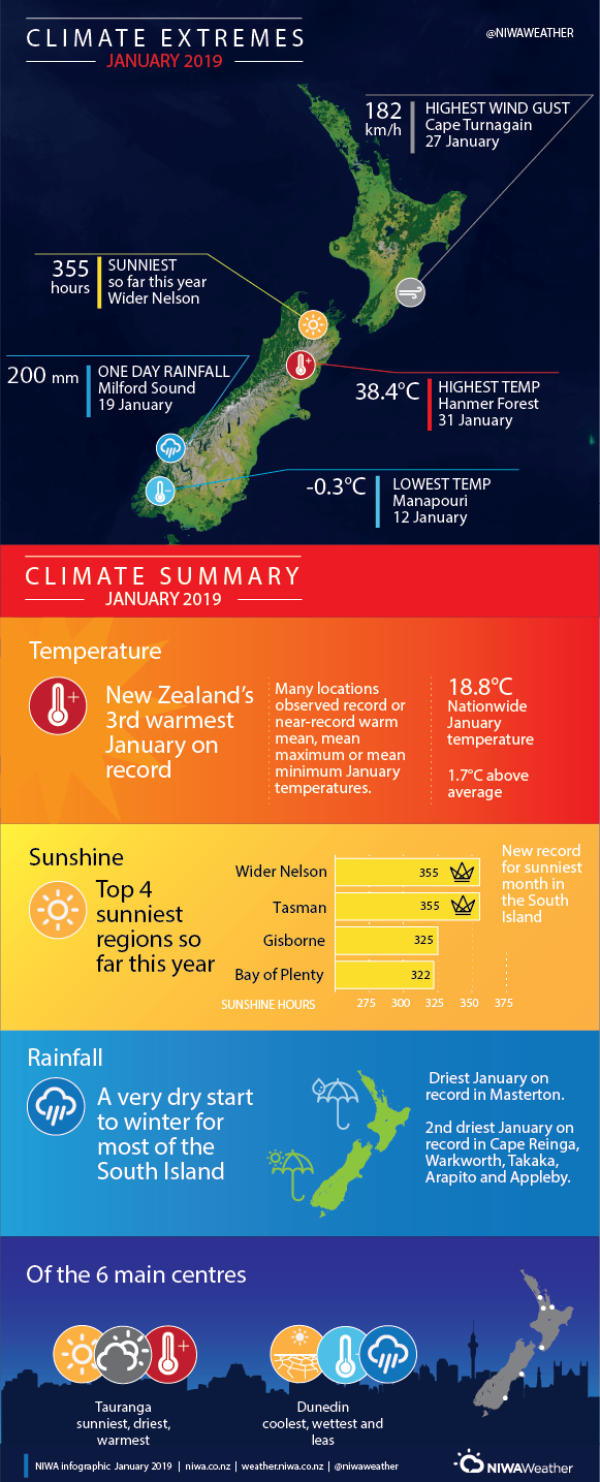New Zealand’s 3rd warmest January on record
|
Temperature |
It was New Zealand’s 3rd warmest January on record. Temperatures were above average (0.51-1.20°C above average) and well above average (> 1.20°C above average) across the country. The only exceptions were the coastal margins of Westland and western Southland where temperatures were near average (-0.50°C to +0.50°C of average). Many locations observed record or near-record warm mean, mean maximum or mean minimum January temperatures. |
|
Rainfall |
Rainfall was below normal (50-79% of normal) or well below normal (<50% of normal) across much of the North Island. The only exception were the districts of Napier and Hastings where above normal rainfall was observed (120-149% of normal). In the South Island, rainfall was well below normal in Nelson, Marlborough, Tasman and parts of Canterbury. For the remainder of Canterbury and the upper West Coast, rainfall was below normal. Conversely, above normal rainfall was observed in parts of Otago and Southland. |
|
Sunshine |
The dry weather across the country meant that sunshine was plentiful with large parts of the country experiencing higher than normal sunshine hours. Both Richmond (Nelson) and Appleby observed 355 sunshine hours which is a record for the sunniest month ever recorded in the South Island. Nelson (Airport) observed 333 hours of sunshine making it the sunniest January on record there since records began in 1908. Gisborne also experienced its sunniest January on record (records began in 1905) with 325 hours of sunshine. |
|
Soil Moisture |
As of 2 February soil moisture levels were lower than normal in Northland, Auckland, parts of Waikato, Manawatu-Whanganui, Wellington, Tasman, Nelson, Marlborough and the Buller District. Soil moisture levels were largely near normal around Canterbury, Otago, Southland, Hastings District and Gisborne. |
Overview
January 2019 was characterised by lower than normal pressure to the south and south-east of New Zealand and higher than normal pressure over the Tasman Sea. This pressure set up led to more south-westerly winds than normal across the country. Warmer than average sea surface temperatures persisted throughout January around New Zealand’s coastlines and marine heatwave conditions were observed in parts of the central and western Tasman Sea.
January was a hot month with many locations experiencing record or near-record warm mean, mean maximum and mean minimum January temperatures. Overall, the month ranked as the 3rd warmest January on record. The nationwide average temperature in January 2019 was 18.8°C (1.7°C above the 1981-2010 January average from NIWA’s seven station temperature series which begins in 1909). For comparison, January 2018 was New Zealand’s warmest month on record and had a mean temperature of 20.3°C. It has now been 24 months since New Zealand experienced a nationwide average temperature that was below average (0.51 to 1.20˚C below the 1981-2010 average).
The month ended on a particularly hot note during which widespread heatwave conditions led to several locations experiencing their warmest January day on record. The warmest temperature during the month was 38.4˚C recorded in Hanmer Forest. This was Hanmer Forest’s warmest temperature on record (data since 1906) and New Zealand’s 18th-equal warmest temperature on record for all months.
With a high pressure pattern overhead, widespread dry conditions prevailed across much of the North Island and upper South Island. According to the New Zealand Drought Index, meteorological drought conditions were being approached near Westport as of 2 February. Cape Reinga observed just 4 mm of rain in January which was the 2nd driest January on record there (records beginning in 1919). In Masterton, only 6mm of rain fell during the month, making it the driest January on record there since records began in 1926. The dryness went hand in hand with high sunshine hours around the country. The stations in Richmond and Appleby both recorded 355 hours for the month which is a new record for the sunniest month in the South Island. This is also just 1 hour short of the national record which is 356 hours and was observed in New Plymouth in January 2015.
Further highlights
- The highest temperature was 38.4°C, observed at Hanmer Forest on 31 January.
- The lowest temperature was -0.3°C, observed at Manapouri on 12 January.
- The highest 1-day rainfall was 200 mm, recorded at Milford Sound on 19 January.
- The highest wind gust was 182km/h, observed at Cape Turnagain on 27 January.
- Of the six main centres in January 2019, Tauranga was the warmest, driest and sunniest and Dunedin was the coolest, least sunny and wettest.
- Of the available, regularly reporting sunshine observation sites, the sunniest four regions in 2019 are Wider Nelson (355 hours), Tasman (355 hours), Gisborne (325 hours) and Bay of Plenty (322 hours).
Download
January 2019 climate summary information [PDF 1MB]
January 2019 climate statistics [PDF 75KB]
Contact
Nava Fedaeff, Climate Scientist
Tel. 09 375 6337

